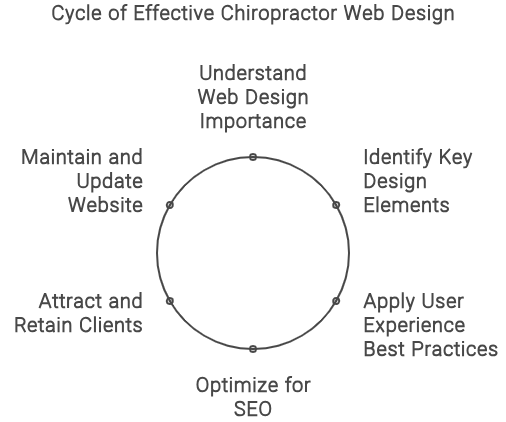
As a web design expert with over a decade of experience working with healthcare professionals, including chiropractors, I’ve seen firsthand how a well-designed website can impact a practice’s success. In this comprehensive guide, I’ll share my expertise on the essential elements of effective chiropractor web design, from aesthetics to functionality, to help you create a compelling online presence that attracts and retains clients in today’s competitive market.

Understanding the Importance of Web Design for Chiropractors
In the digital age, a solid online presence is crucial for chiropractors looking to attract new patients and grow their practice. According to a study by the Pew Research Center, 77% of health seekers begin their search for health information online.
A professional, well-designed website:
- Serves as a virtual storefront for your practice
- Reflects your brand and expertise
- Provides valuable information to potential patients
- Facilitates appointment scheduling and contact
- Improves your visibility in search engine results
By investing in tailored web design, chiropractors can establish a competitive edge and build trust with their target audience.
Critical Elements of Effective Chiropractor Web Design
To create a website that engages visitors and converts them into patients, chiropractors should focus on incorporating the following key elements:
- Straightforward Navigation: A user-friendly menu that allows visitors to quickly find the information they need, such as services, about us, and contact pages.
- Mobile Responsiveness: A design that adapts seamlessly to various screen sizes, providing an optimal viewing experience on desktops, tablets, and smartphones. Google reports that 61% of users are unlikely to return to a site that isn’t mobile-friendly.
- Compelling Visuals: High-quality images and videos that showcase your practice, staff, and facilities, helping to build trust and credibility with potential patients.
- Informative Content: Well-written, engaging content that educates visitors about chiropractic care, conditions treated, and your expertise, establishing you as a trusted authority in your field.
- Calls-to-Action (CTAs): Prominent buttons or links that encourage visitors to take specific actions, such as scheduling an appointment or contacting your practice.
- Contact Information: Easily accessible contact details, including phone number, email, and physical address, to make it simple for potential patients to reach out to you.
- Patient Testimonials: Authentic reviews from satisfied patients that provide social proof and build trust with prospective clients. BrightLocal reports that 79% of consumers trust online reviews as much as personal recommendations.
- Appointment Scheduling: An integrated online booking system that allows patients to easily schedule appointments directly through your website, reducing barriers to entry.
- SEO Optimization: Implementing search engine optimization best practices, such as keyword targeting and meta descriptions, to improve your website’s visibility in search results and attract organic traffic.
- Fast Loading Speed: A website that loads quickly, ideally within 2-3 seconds, to prevent visitors from abandoning your site due to slow performance. Google reports that 53% of mobile users leave a page that takes longer than 3 seconds to load.
Chiropractors can create a website that effectively engages and converts their target audience by incorporating these essential elements.
Navigating the User Experience Best Practices for Chiropractic Websites
User experience (UX) design focuses on creating websites that are intuitive, accessible, and enjoyable for visitors to navigate. By prioritizing UX best practices, chiropractors can improve patient satisfaction, reduce bounce rates, and increase conversions.
Key UX considerations for chiropractic websites include:
- Intuitive Navigation: A logical site structure with clear, descriptive labels that make it easy for visitors to find the necessary information.
- Responsive Design: A layout that adapts to various screen sizes, ensuring a seamless device experience.
- Fast Load Times: Optimized images, minimized HTTP requests, and compressed files to ensure quick loading speeds and prevent visitor frustration.
- Accessible Content: Using headings, subheadings, and bullet points to break up text and make content easy to scan and read.
- Consistent Branding: A cohesive colour scheme, typography, and imagery that reflect your brand identity and create a professional, trustworthy appearance.
By focusing on UX, chiropractors can create websites that look great and function seamlessly, providing a positive experience for visitors and encouraging them to take action.
Responsive Design Ensuring Accessib SEO Essentials: Optimizing Your Website for Search Enginesility Across Devices
Search engine optimization (SEO) is crucial for chiropractors looking to attract organic traffic and improve their visibility in search results. By implementing SEO best practices, you can help potential patients find your website when searching for chiropractic services in your area.
Key SEO strategies for chiropractic websites include:
- Keyword Research: Identifying the terms and phrases your target audience uses when searching for chiropractic services and incorporating them naturally throughout your website’s content.
- On-Page Optimization: Optimizing your website’s title tags, meta descriptions, header tags, and content to include relevant keywords and provide a clear, concise overview of each page’s content.
- Local SEO: Claiming and optimizing your Google My Business listing, building local citations, and incorporating location-specific keywords to improve your visibility in local search results.
- Content Creation: Regularly publishing high-quality, informative blog posts and articles that target relevant keywords and provide value to your audience, helping to establish your expertise and attract inbound links.
- Link Building: Acquiring high-quality, relevant backlinks from reputable websites to improve your website’s authority and visibility in search results.
By investing in SEO, chiropractors can improve their online visibility, attract more qualified traffic, and ultimately generate more leads and patients for their practice.


